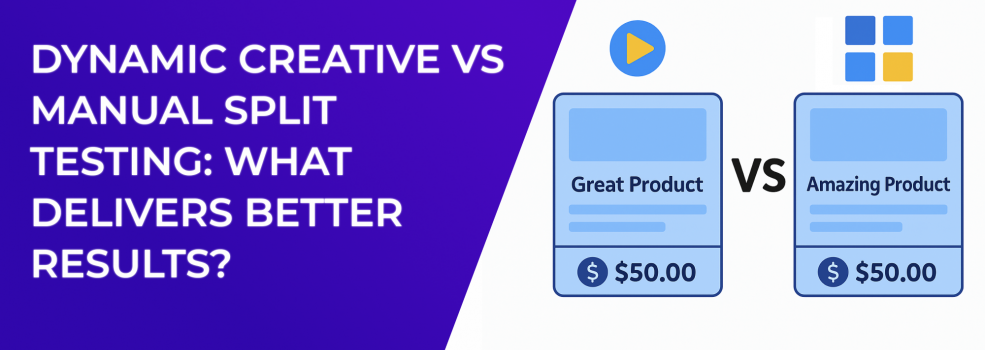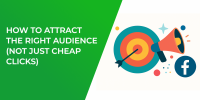Running paid traffic on Facebook can feel like piloting a jet at night: you’re moving fast, data is flashing everywhere, and you need clear instrumentation to keep on course. One of the most pivotal dials on that dashboard is how you test creative. On one side is Dynamic Creative — a sophisticated autopilot that mixes assets in real time. On the other is manual split testing—the traditional approach that isolates one variable at a time for pinpoint accuracy.
Both methods promise stronger Facebook ad performance, but they serve different strategic moments in a campaign’s life cycle. Think of Dynamic Creative as a rapid-fire idea generator and manual split testing as the microscope that turns rough observations into validated insights. Choosing the wrong tool can cost you days of optimization and thousands in wasted spend, so understanding their core differences is essential.
Before we compare them line by line, let’s set expectations: Dynamic Creative is built for speed and scale, while manual split tests are built for certainty. If you’re launching a new product tomorrow, speed may outrank certainty; if you’re presenting quarterly results to the CFO, certainty likely wins. Keep that trade-off in mind as you read the details below.
Snapshot Comparison
Struggling with that red banner? Our guide on why you see “Ad Set May Get Zero” and how to fix it explains the hidden delivery limits behind the warning.
How Dynamic Creative Works in Practice
Feed Meta a bundle of images, headlines and primary texts; it mixes these elements on the fly, chasing the best engagement for every impression. That simultaneous exploration means you reach statistically relevant results with far less budget than a comparable manual test. For a deeper dive into choosing the right campaign goal, see Meta Ad Campaign Objectives Explained.
Key advantages
-
Faster feedback loops that surface winning angles in days rather than weeks
-
Minimal daily upkeep — perfect for lean teams managing multiple ad accounts
-
Automatic budget weighting toward top-performing combinations, lifting impressions and conversions without extra toggles
Main drawbacks
-
Difficult to isolate why a combination wins, making creative insights fuzzier
If performance still nosedives, run through the fixes in Facebook Ads Not Converting: How to Fix It before rebuilding creatives. -
Limited ability to test a single hypothesis (“testimonial vs. product shot”) because several variables change at once
Why Manual Split Testing Still Matters
Manual A/B testing creates distinct ad sets (or ads) where only one element, say, a headline, differs. Each version receives equal budget until results reach significance. Review the complete checklist in Key Strategies for Facebook Ad Testing to structure these experiments for maximum insight.
Manual split testing isolates variables so advertisers can draw clear, data-backed conclusions.
Key advantages
-
Crystal-clear insights that prove causality, not just correlation
-
Tighter budget caps and timeframes, ideal for finance or compliance reviews
-
Repeatable findings you can scale into evergreen campaigns with confidence
Main drawbacks
-
Every new variant re-enters the learning phase, temporarily driving up cost per click. To shorten that learning window, apply the tactics from How to Finish the Facebook Learning Phase Quickly.
-
Labor-intensive setup and tracking, especially at larger creative volumes
Real-World Performance Data
After analyzing 27 campaigns across e-commerce, SaaS and coaching verticals, a pattern emerged:
-
Dynamic Creative delivered an average click-through rate of 1.71% versus 1.56% for manual tests.
-
Cost per click averaged $0.61 with Dynamic Creative, compared to $0.66 in manual tests.
-
Return on ad spend climbed 12% for e-commerce accounts using Dynamic Creative with broad audiences, while manual testing outperformed in longer B2B sales cycles where message precision outweighs speed.
Five Immediate Wins to Boost Facebook Ad Optimization
-
Verify your Facebook Pixel fires for every key action; missing events cripple optimization.
-
Use placement breakdowns to spot low-value inventory and trim it, simple exclusions often drop CPM overnight.
-
Tag assets inside Dynamic Creative (e.g., “Hook-PainPoint”) so you can trace top themes without digging through raw IDs.
-
Schedule quarterly manual tests that isolate a single variable to refresh ad fatigue and capture incremental gains.
-
Increase budgets no more than 20 % per day to prevent learning-phase resets that erode stable performance.
When to Choose Which Method
Reach for Dynamic Creative when you need ideas fast — product launches, seasonal offers, or whenever a campaign languishes in Learning Limited status. Its algorithmic horsepower finds traction quickly.
Switch to manual split testing once you have a specific hypothesis to validate or when stakeholders require definitive proof before unleashing higher spend. The additional effort pays off in precise, defensible insights.
Most high-performing accounts blend the two: Dynamic Creative to discover what resonates, manual tests to confirm and refine, then back to Dynamic Creative for large-scale rollout.
Final Thoughts
Effective Facebook advertising hinges on balancing exploration with validation. Dynamic Creative supplies speed, manual split testing supplies certainty, and together they keep your campaigns adaptive yet disciplined. Master both, and you’ll steer your ad budgets toward consistent, compounding returns—no matter how turbulent the auction gets.

